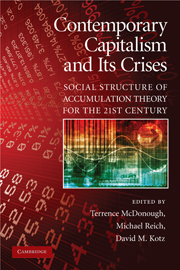Book contents
- Frontmatter
- Contents
- List of Tables
- List of Figures
- List of Contributors
- Acknowledgments
- Introduction: Social Structure of Accumulation Theory for the 21st Century
- PART I THE THEORY OF SOCIAL STRUCTURES OF ACCUMULATION
- PART II GLOBALIZATION AND THE CONTEMPORARY SOCIAL STRUCTURE OF ACCUMULATION
- PART III THE CONTEMPORARY SOCIAL STRUCTURE OF ACCUMULATION IN THE UNITED STATES
- PART IV SOCIAL STRUCTURE OF ACCUMULATION THEORY AND TRANSFORMATIONS OF THE CAPITALIST PERIPHERY
- 11 The Social Structure of Accumulation in South Africa
- 12 Social Structures of Accumulation and the Condition of the Working Class in Mexico
- 13 Social Structure of Accumulation Theory for the Arab World: The Economies of Egypt, Jordan, and Kuwait in the Regional System
- Index
- References
13 - Social Structure of Accumulation Theory for the Arab World: The Economies of Egypt, Jordan, and Kuwait in the Regional System
Published online by Cambridge University Press: 05 June 2012
- Frontmatter
- Contents
- List of Tables
- List of Figures
- List of Contributors
- Acknowledgments
- Introduction: Social Structure of Accumulation Theory for the 21st Century
- PART I THE THEORY OF SOCIAL STRUCTURES OF ACCUMULATION
- PART II GLOBALIZATION AND THE CONTEMPORARY SOCIAL STRUCTURE OF ACCUMULATION
- PART III THE CONTEMPORARY SOCIAL STRUCTURE OF ACCUMULATION IN THE UNITED STATES
- PART IV SOCIAL STRUCTURE OF ACCUMULATION THEORY AND TRANSFORMATIONS OF THE CAPITALIST PERIPHERY
- 11 The Social Structure of Accumulation in South Africa
- 12 Social Structures of Accumulation and the Condition of the Working Class in Mexico
- 13 Social Structure of Accumulation Theory for the Arab World: The Economies of Egypt, Jordan, and Kuwait in the Regional System
- Index
- References
Summary
Applying SSA Analysis to the Arab World
The theory of social structures of accumulation (SSA) was developed to explain long swings of alternating expansion and stagnation in Western capitalist economies. The post-World War II SSA led by the United States entailed the projection of U.S. military power overseas, the allocation of U.S. foreign aid to allies and protégés, and the investment of U.S. surplus capital abroad. U.S. hegemony provided assurance of energy and raw material supplies and new arenas for the global spread of capitalist production, as well as the growth of markets for the United States and, increasingly, Western European and Japanese exports. Because many areas of the Arab region were rich in easily extractable sources of energy and conveniently located near Europe, controlling the region became an integral part of the U.S. economic and political strategy as it replaced shrinking British and French imperial power.
The importance of SSA analysis is double-barreled for understanding economies of the Arab World. First, the establishment and evolution of this “post-World War II SSA” led by the United States, and its evolving contradictions, constituted the international context within which the Arab territories attained political independence as new “nations” and undertook “modern” economic development. Second, the SSA conceptual apparatus can be used to examine the economic achievements and internal contradictions of the Arab countries and the institutions facilitating or impeding accumulation in each period of their postwar history.
- Type
- Chapter
- Information
- Contemporary Capitalism and its CrisesSocial Structure of Accumulation Theory for the 21st Century, pp. 309 - 354Publisher: Cambridge University PressPrint publication year: 2010
References
- 2
- Cited by



